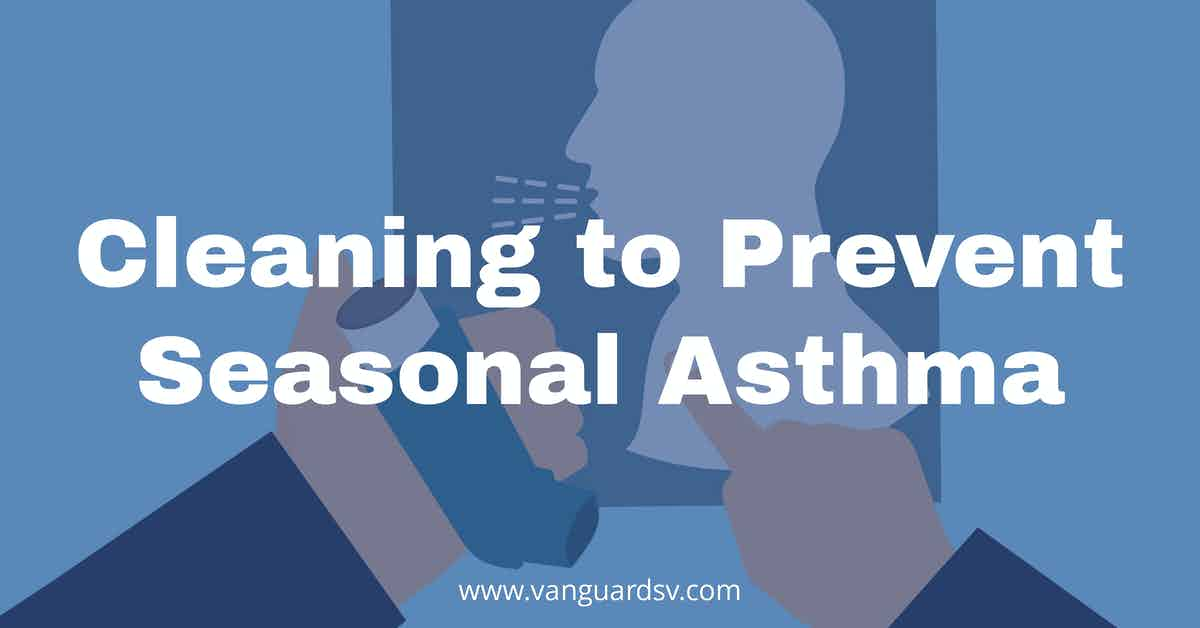High-performance cleaning reduces the presence of allergens, pests, and particles that contribute to seasonal asthma symptoms and attacks that contributed to the death of thousands of people in the U.S. each year.

Combatting Seasonal Asthma With Enhanced Cleaning for Health
Asthma-related mortality accounts for roughly 3000-3500 deaths in the U.S. per year, with an average of 9.3 deaths per million residents in California, and primarily impacts those aged 5-34 years, June through August.
For persons aged 5 through 34 years, hospitalizations peaked in September through November, whereas mortality trends peaked in June through August.
A disproportionate number of the summer deaths in this age group occurred out of the hospital.
For individuals 65 years old or older, both asthma hospitalizations and mortality demonstrated increases during December through February.
Seasonal or allergic asthma is often triggered by high temperatures, humidity, increased exercise, and other common summertime challenges, including:
- Mold and mildew.
- Dust mites.
- Pollen.
- Cockroaches, and;
- Animal dander.
Other factors that commonly trigger allergic reactions resulting in asthma attacks include exposure to chemicals found in many commercial cleaning products, something more than less likely to happen in the current post-pandemic environment.
Eliminating these triggers while improving facility hygiene and occupant health is possible with the same enhanced cleaning measures that rose to prominence during the peak of the pandemic.
Facility Cleaning Tips to Prevent Seasonal Asthma Symptoms and Attacks
Eliminating allergy-induced asthma symptoms and attacks in classrooms and businesses is critical to occupant health and safety.
All of the recommendations carry-over benefits to all occupants and have been shown to increase mental health, physical wellness, and productivity.
The first step is to eliminate clutter in the immediate workspace and then around the occupied areas of the building.
This will eliminate places for cockroaches to hide and simplify the dusting and cleaning process for housekeeping and custodial teams.
Increasing indoor airflow has several benefits, including:
- Dispersing air pollutants and particles, including SARS-CoV-2 microbes, in the air, thereby;
- Improving indoor air and environmental quality, which has a direct impact on occupant wellness and productivity, and;
- A decrease in indoor air humidity, which has a direct impact on seasonal allergies and asthma.
Ensuring that the work area is unoccupied, especially by those who are in the sensitive group when cleaning, dusting, and disinfecting, will significantly reduce the likelihood of exposure to dust and chemicals that are off-gassed from commercial disinfectants during the sanitation process.
When and where that is not possible, alternative disinfectant products carrying the EPA Safer Choice or EWG label will reduce the number of volatile organic compounds released into the air, resulting in fewer triggers and reactions.
Additionally, it is highly recommended that facility cleaning and maintenance teams avoid the use of perfumed air fresheners, as these off-gas harmful chemicals that can combine with other microbes in the air and form a kind of synthetic formaldehyde.
Finally, increasing the frequency of facility cleaning using:
- HEPA-filtered vacuums.
- Microfiber mops, brooms, and towels, and;
- Environmentally preferable cleaning products;
has been shown to not only reduce the presence of harmful pathogens like the coronavirus, but dust particles, allergens, pathogenic bacteria, and allergy-triggering molds and mildew.
References & Resources
- Asthma - Mortality Data
- Cleaning Mold, Mildew and Other Triggers
- Allergies & Asthma
- Summer Allergy-Induced Asthma
Takeaway
Asthma sufferers, even those with mild to moderate symptoms, can experience acute attacks during the hottest parts of the year.
According to Everyday Health;
People with mild asthma may find that when summer temperatures soar, along with humidity levels, their asthma symptoms begin to act up.
Breathing in such hot environments could lead to coughing and shortness of breath, suggests research reported in the American Journal of Respiratory and Critical Care Medicine.
The researchers found that a room temperature of about 71 degrees Fahrenheit did not trigger asthma symptoms, but breathing in super-hot air at 120 degrees F did.
They concluded that summer asthma exacerbations could be due, in part, to heat stress that affects the physiology of your airways and leads to an asthma reaction.
At the same time, you might trace episodes of summer asthma to smog and other environmental pollutants.
Eliminating clutter, increasing cleaning frequencies and indoor airflow, and improving the quality of cleaning products and processes will have a major impact on the health of facility occupants.
Outsourcing is a proven method for onboarding these increasingly in-demand services, tools, and expertise for a fraction of the cost of maintaining a similar service in-house.
If you would like more information regarding the effectiveness of high-performance infection prevention and control measures, or if you would like to schedule a free, no-obligation onsite assessment of your facility's custodial needs, contact us today for a free quote!
In Bakersfield, CA, call (661) 437-3253
In Fresno, CA, call (559) 206-1059
In Valencia CA, or Santa Clarita CA, call (661) 437-3253
In Palmdale, CA or Lancaster, CA, call (661) 371-4756

